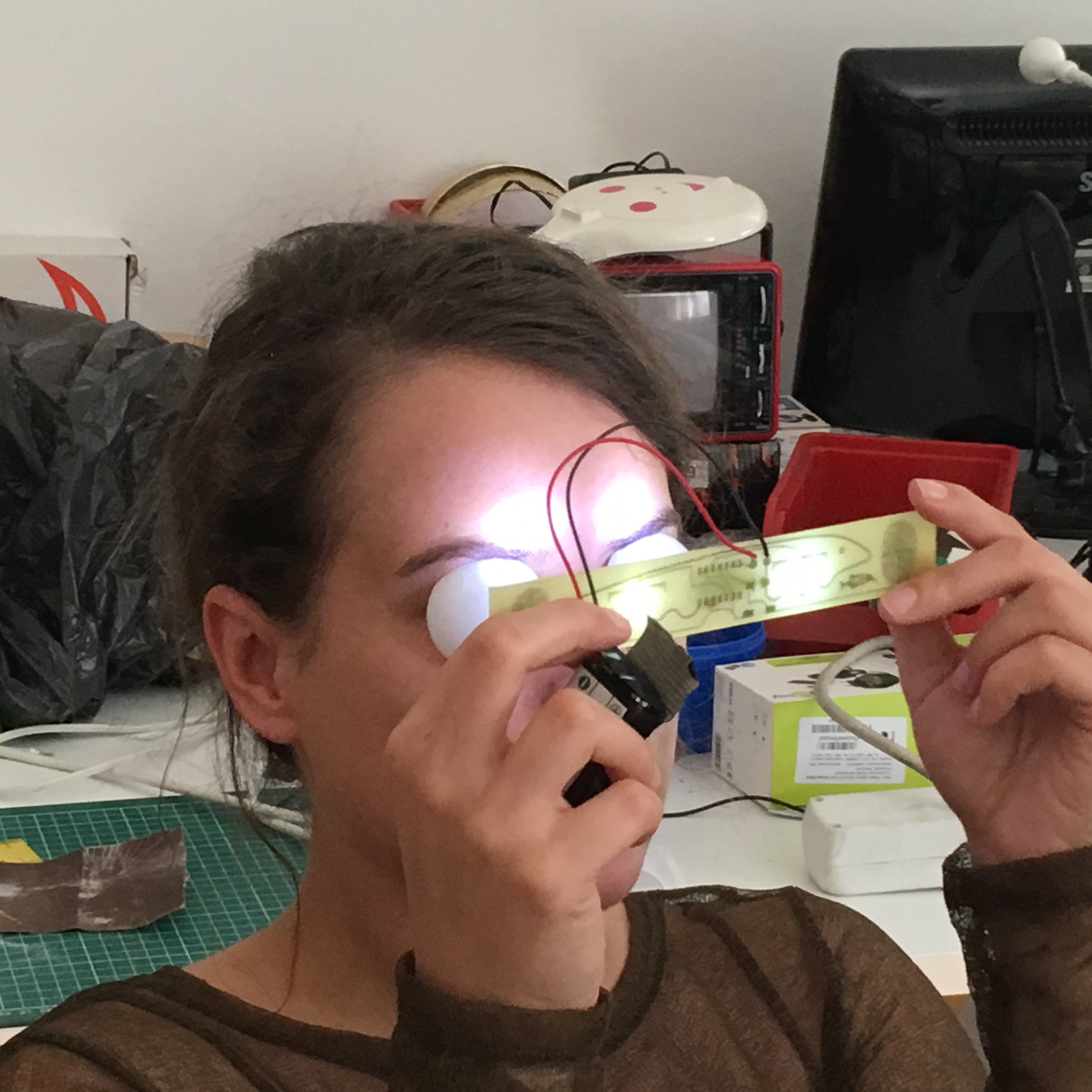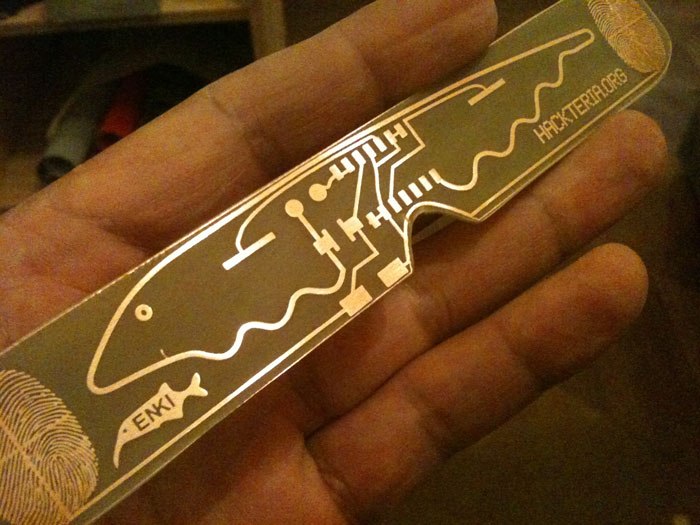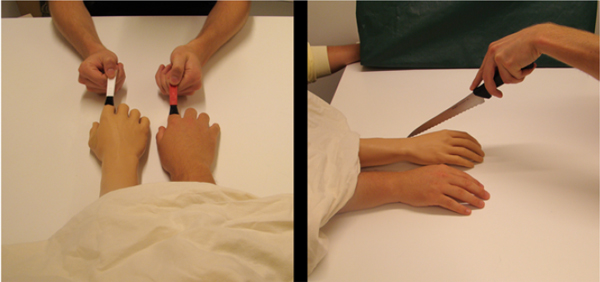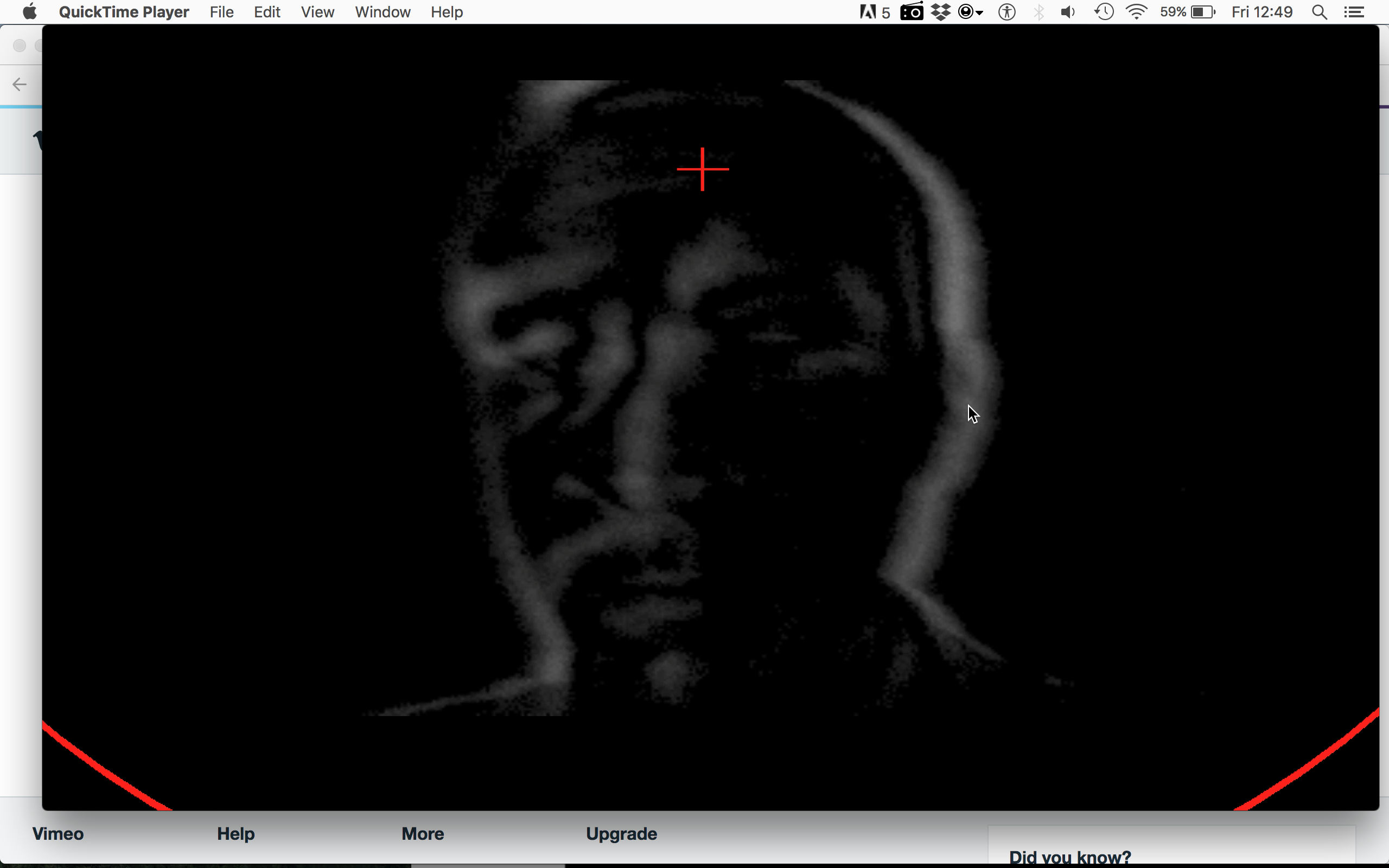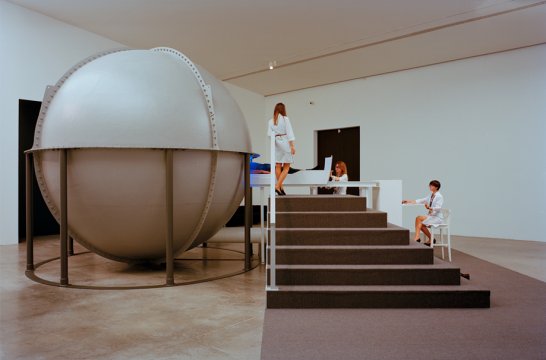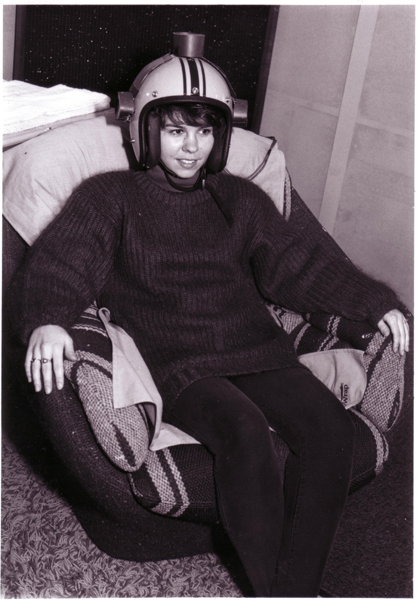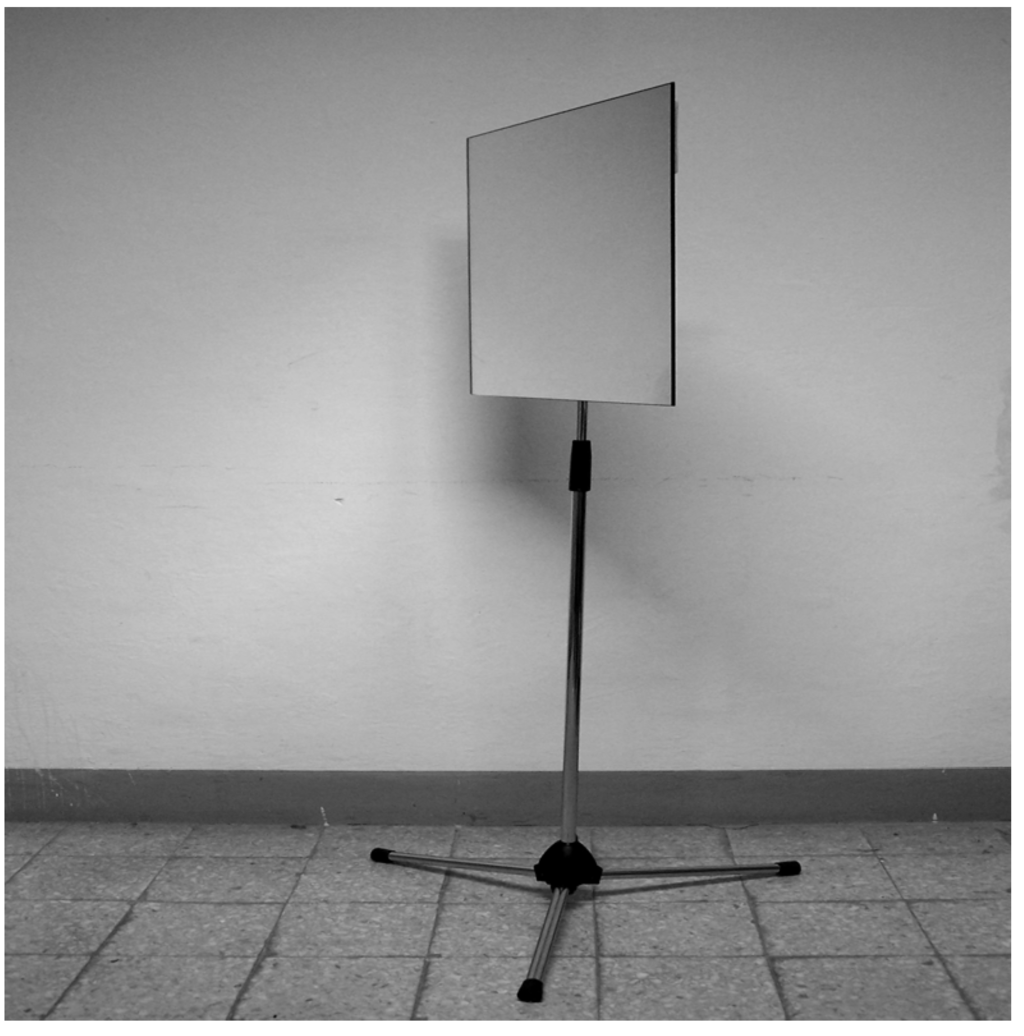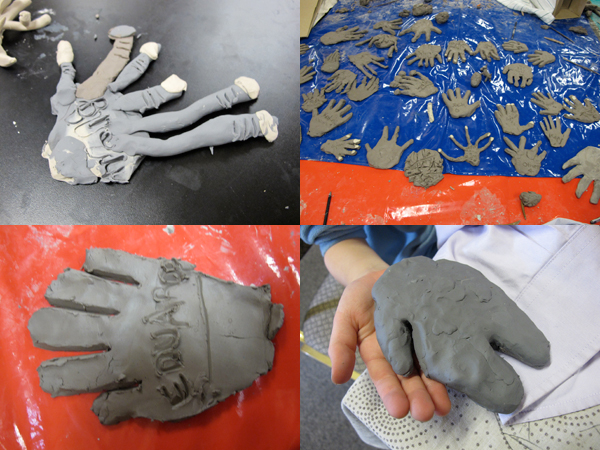I chose to draw each clay object created for the unfeasible objects experiments. Why? The photographs don't seem to do justice to the significance of the object, its purpose and the process its undergone. Both with my self and the participant. They say drawing itself is a form of embodiment. "In the gesture of a drawing, there abides the question of how human beings hold memory. A trace of the body, the projection of an emotion, a record of the experience of seeing are woven into the gestured mark, a kinetically vitalized inscription that can serve as a site of empathy and invitation as much as a line of mimetic description" Marking Time, Figuring Space: Gesture and the Embodied Moment. Sara Schneckloth The
Author: antonyhall
Clay hand experiments at Radiona
Some documentation from the workshop at Radiona in Zagreb [See Re-mapping the senses workshop] [For more information about the clay hand experiment see here] [For more information about the clay hand experiment see here]
Proprioceptive drift visualisation
[wpvideo VartTqKO ] My experiments show a strong ‘drift’ in the perceived location of the hand before and after the experiment. This is known as proprioceptive drift. I asked people to locate the position of their index finger under a platform before and after embodying a clay object. And also draw their hand without looking before and afterwards. This animation shows these superimposed, illustrating the drift away from the real location of the hand.
Fish-brain-machine / Radiona workshop
After constructing the Fish-brain-machine PCB circuits we spent some time experimenting and describing the hallucinogenic visuals created by the stroboscopic light. The ping pong balls over the eyes diffuse the LED light, making for a more intense effect - and enabling use with eyes open. Here they describe some of the effects including seeing colours and 'a strange experience' of seeing with only one eye - I get this exact same feeling when using it. It is also hard to know if your eyes are open or closed. [See also Re-mapping the senses workshop ] https://www.youtube.com/watch?v=Lwne5xICLkI
Spontaneous sensations
Possibly one of the simplest experiments possible to conduct, requiring no special equipment. Simply stare at your hand for 5 mins. The experiment is described in the paper “the tickly homunculus and the origins of spontaneous sensations arising on the hands" in which you focus on your hand while staring at it (convergent focusing) or divergent focusing (staring at red marker next to the hand you are focussing on) for just 10 seconds and report the sensations. Here are the outcomes superimposed from 8 participants. In this experiment, many of the bemused participants described a tingling where the hand made contact with the table. They were bemused because I did this experiment in the context of our methods and methodologies discussion group - where I was
Radiona workshop, Zagreb
I'm doing a workshop related to my research, perceptual illusions and altering perception through experiments, Clay hand illusion and other activities based on sound and light and taste, at Radiona Zagreb, 21-22/04/2018 https://radiona.org/ check out the web Re-mapping the senses workshop page and resources here...
Fish-brain-machine
As part of my Enki exhibition at Kapellica Gallery in Ljubljana 2012, I developed a related perceptual illusions and brain hacks workshop with Marc Dusseiller [Hackteria], as part of the gallery’s Biotech program. We came up with the idea to make a special issue circuit for the workshop and we set to work designing a circuit the encapsulated the Enki project in miniature. After a couple late nights, we came up with this super cool PCB design. Marc worked hard to create a fully functional efficient design, which was also aesthetically pleasing. The outline of the fish is also the ground in the circuit. This has to be the most ultra minimal brain-machine available to build. 6 components. We spent further
Strange face illusion with two-way Mirror feedback
“… a quiet room dimly lit by a 25 W incandescent light. The lamp was placed on the floor behind the observer so that it was not visible either directly or in the mirror. A relatively large mirror (0.5 m60.5 m) was placed about 0.4 m in front of the observer. The luminance of the reflected face image within the mirror was about 0.2 cd mÿ2 and this level allowed detailed perception of fine face traits but attenuated colour perception…The task of the observer was to gaze at his/her reflected face within the mirror. Usually, after less than a minute, the observer began to perceive the strange-face illusion…” Giovanni B Caputo, Perception, 2010, volume 39, pages 1007 – 1008 2010
Mechanically Augmented Reality
When I first learned about the Rubber hand illusion [RHI] I immediately began to think about ways in which the process could be automated to create an artwork, in which the experimenter's presence was removed. This could be done using sensors and a microcontroller to articulate solenoids to tap fingers for example. That thought train was on a back burner until discovered the work of fellow MMU PGR Lin Charlston. As part of her PhD research [See her profile here 'The Multimodal book as organism, artefact and assemblage: non-human agency in processes of growing and making'] She invented a beautifully simple, entirely mechanical device just to do exactly this. Your hand is placed inside a box, while the other hand turns a crank. On top of the box, another rubber hand
On the embodiment of unfeasible objects
Further to my last post detailing experiments relating to the embodiment of invisible and even third hands, here are some notes on my first 'Clay hand Illusion' experiments... The ‘Rubber hand illusion’ shows it is possible to convince participants that a rubber hand is their own by placing it in front of them while stroking it in the same way as their hidden real hand. The use of self-made clay hands, or objects [see below] in place of the rubber hand raises several interesting possibilities for exploration, which move away from the embodiment of replica body parts, and towards the possible embodiment of modified body parts, or completely 'unfeasible' objects.The clay allows for the gradual and immediate morphing of forms and for the
Illusions of Invisible, alien hands, 3 arms, and shrinking bodies…
I have previously posted about the original 'rubber hand illusion' in which participants are convinced a fake rubber hand is their own. A classic low tech experiment that can help us "understand how sight, touch and “proprioception” the sense of body position, combine to create a convincing feeling of body ownership, one of the foundations of self-consciousness (Nature 1998, vol 391, p 756 )” Further to this research recent studies have gone on to experimentally induct of out of body experiences or create body swap illusions. [ Henrik Ehrsson and Olaf Blanke http://www.eurekalert.org/pub_releases/2007-08/ucl-foe081407.php ] Between these two experiments, several interesting versions of hand-related experiments also exist which demonstrate the plasticity of our body perception... The Alien Hand Experiment first created in the 1960s predates the Rubber hand experiment, seems more 'trick'
Blind drawing of hand
Blind drawing of hand starting from the left and using a continuous line, before and after experiments. Could this exercise be used as a measure of "proprioceptive drift" before and after 'Rubber hand illusion' type experiments? I will be exploring this idea soon with the research group at BEAM lab...
Clay hand drawings
Here are are a selection of drawn outlines of clay hands created by workshop participants aged 6 to 12 for the original clay hand experiment (see posts tagged rubber hand or clay hand) Participants of all ages were asked to create a hand and use it in place of a replica rubber hand, the idea was to test if a self-created hand was easier to connect with. The hands were then taken and worked on further, sometimes becoming more distorted and abstract.
Face as Interface
Trying to create a simple motion tracking patch using PD_extended and Gem, I came across this project by Elektro Moon Vision http://elektromoon.co.nr/ the mini App provides OSC data from movements such as eyebrows, nose, mouth, orientation scale etc. This is massively useful for an experiment I have in mind related to the "strange face in the mirror illusion" The data can be captured and used to control a 3D model in virtual space for example. Matching rotation, scale and orientation to the model and the movement of my head... This is a simple motion detection patch that tracks the difference between two frames creating ghostly outlines of momentarily disembodied features. It's sensitive enough to pick up facial expressions such as the movement of muscles and
Drawing a strange face in the dark
Shortly after my experience of the "Strange face in the mirror experiment" I made these drawings in low light conditions as a way of recording the perceivable elements of my face and shape of the head. The particles of carbon and graphite reflect well the visual noise, like static, one experiences in the experiment. These drawings don't illustrate the hallucinations I experienced [these will follow] "staring at one's own reflection in a mirror in a darkened room for some time can induce vivid hallucinations. For purposes of research, I had to try it" My experience of the ‘strange face illusion’... For my description of my experience of the 'strange face', illusion see here... "staring at one's own reflection in a mirror in a darkened room for
Mixing object actions and context
This research looked at how we respond to the observation of actions and how the context affects our neural processing of that action. I was fascinated to learn simply by observing an action with an object that can be potentially used for an action - such as a potato peeler - the brain seems to simulate this action. But what happens when we observe an object being used for an action in an unusual context? Or what happens if we see an object being used for an unusual action, perhaps even in an unusual space. The experiments used videos of a person performing a task with specific objects in specific contexts such as cracking and egg into a bowl in the kitchen. and was then repeated in
Rubber hands ‘feel’ touch that eyes see
The first report on the Rubber Hand illusion. Published in Nature in 1998 by Matthew Botvinick, and Jonathan Cohen of the Department of Psychiatry, University of Pittsburgh... "We report here an illusion in which tactile sensations are referred to an alien limb. The effect reveals a three-way interaction between vision, touch and proprioception, and may supply evidence concerning the basis of bodily self-identification." "It has been proposed that the body is distinguished from other objects as belonging to the self by its participation in specific forms of intermodal perceptual correlation7,8. Subjects in our first experiment who referred their tactile sensations to the rubber hand also consistently reported, in both sections of the questionnaire, experiencing the rubber hand as belonging to themselves. Indeed,
James Turrel – Light Reignfall
[vimeo 75419053 w=640 h=360] James Turrell's Light Reignfall @LACMA - Andrew van Baal James Turrell's Light Reignfall Light Reignfall is a work from his series of perceptual cells, inside the participant is exposed to a uniform homogenous field of modulated light. A combination of sensory overstimulation, yet deprived of recognisable forms or space, hallucinatory effects are experienced. “Assisted by an attendant, an individual viewer enters a spherical chamber on a sliding bed. A program of saturated light (operated by a technician) surrounds the viewer for twelve minutes, allowing the visitor to experience the intense, multi-dimensional power of light and the complex seeing instrument of the human eye.” "James Turrell (b. 1943, Los Angeles), a key artist in the Southern California Light and Space movement
Notes on olfactory art
Olfactory art or Scent art has been growing over recent years, And I would agree with the premise, that 'it has been long disregarded as one of the lower senses' [scentart.net] I remember turning up for the opening of my own exhibition and discovering that along with the beverages, a selection of delicious snacks had been presented on tables placed inside the gallery space. The smell of the food filled the gallery and I felt at the time that this took away from the work. The smells that would have accompanied the work would have been, hot electronics and detergent. perhaps a hind of coffee from another experiment. Here are a few links to useful sites/research on the subject: "The sense of smell has long been
What is Somaesthetics?
The work of Olafur Eliasson and Carsten Höller are prime examples of artists working with perceptual systems in which the viewers become active participants. This could be called 'Perceptual Art' but this term is not widely used, and it has been in a limited sense referring to artwork using optical illusion. In light of this, searching for an umbrella term for artwork that uses experiential and multisensory elements, I stumbled across the term 'Somaesthetics' "an interdisciplinary field whose roots are in philosophical theory, somaesthetics offers an integrative conceptual framework and a menu of methodologies not only for better understanding our somatic experience but also for improving the quality of our bodily perception, performance, and presentation " [1] first coined by Richard Shusterman in 1996 There is
God Helmet
Neurologist Michael Persinger created the God Helmet, an actual helmet modified with electrical coils that can create electromagnetic fields in the wearer's temporal lobes that induces "religious" experiences in the people who put it on. "This is a device to investigate whether religious, spiritual, and mystical experiences had a natural rather than a supernatural source. He speculates that we are somehow programmed so that they can generate religious experiences via our brain's internal processes." I was interested in this experiment because of its use of sensory deprivation and the fact it would be relatively easy to recreate [see my DIY neurostimulation attempt 2009] for my Enki project. My plan was to drive it with frequencies generated by my electric fish [a low
Auditory illusion
Diana Deutsch developed some fascinating auditory illusions. These include the phenomenon of 'speech to song' whereby repeating loops of spoken word suddenly begin to sound like a song. In another illusion, 'phantom words' new words emerge from repeating fragments of words. To experience these all you need are headphones as the a stereo effect is essential, here is the link to her work.… Speech to song http://deutsch.ucsd.edu/psychology/pages.php?i=212 Phantom Words http://deutsch.ucsd.edu/psychology/pages.php?i=211 https://www.youtube.com/watch?v=EWzt1bI8AZ0 A nice example of sine wave speech from Joe Banks [Disinformation] has written about psychoacoustics in his book https://rorschachaudio.com/ I was lucky to meet him at The Sensorium of Animals workshop. "The McGurk effect" is a perceptual illusion that mixes a sound with the visual cue of a different sound, We see the mouth move and hear/see a mismatched sound, check out what happens... https://www.youtube.com/watch?v=aFPtc8BVdJk https://www.youtube.com/watch?v=7uHDMc4TEU8 This
Galvanic sensors
Images of my first GSR [Galvanic Skin Response] sensor hacked from a toy lie detector circuit works well but currently looking for better DIY versions to use in experiments. More research on this to be posted soon.
Acupuncture, brainwaves, and electric fish
Some documentation from a day working with Greg Byatt developing a system to work with the IBVA [Brainwave visulisation] interface. Such as attaching the Electric signal discharge output from the Electric Fish to acupuncture pads placed on our arms, to see if we could perceive the signal and also seeing how the fish behaved. No conclusive results. More time needed! In preparation for the next Enki event, we spent the day testing the neuro-graphic interface; as an experiment, we patched a strong frequency via MIDI to a MAX patch so our brains were modulating all kinds of strange sounds. Later this will combine with the Enki interface as a form of feedback. In this image you can see the graphics of the brain activity and
Enki Manchester Science Museum
Some of the early experiments for the Enki project at Museum of Science and Technology Manchester 2007... We recorded brainwave data and monitored the behaviour of the electric fish during the experiment. The electrical activity of the fish is experienced as sound and light via ENKI (a stroboscopic high frequency led placed close to eyelid) and the natural binaural frequencies produced by the interaction and communication between Black Ghost Knife fish. The participant's bio-electric field was connected to the aquarium allowing the fish to sense a human (bio)electric image or presence. Museum of Science and Industry Manchester, 7th October 2006
Miniature rubber hand experiment
I bought this miniature rubber hand from the welcome trust shop and tried a quick experiment with my 8-year-old son on the train home. I was amazed it seemed to work almost instantaneously. I wonder if it's his extremely tactile nature makes him susceptible to the illusion? In relating to my ideas around experimenting with a clay hand in place of the traditional rubber hand, I went to see the 'Votive offerings' display. The objects are of Roman origin and are made from terracotta, It is believed that there were created in order to cure elements ranging from badness to more serious decreases relating to the body part [intestines, sexual organs, limbs, hair]. these were them thought to have been thrown into
My experience of the ‘strange face illusion’
I had read about this experiment by which staring at one's own reflection in a mirror in a darkened room for some time, can induce vivid hallucinations. For purposes of research, I had to try it. I found my bathroom could meet the following requirements... "... a quiet room dimly lit by a 25 W incandescent light. The lamp was placed on the floor behind the observer so that it was not visible either directly or in the mirror. A relatively large mirror (0.5 m60.5 m) was placed about 0.4 m in front of the observer. The luminance of the reflected face image within the mirror was about 0.2 cd mÿ2 and this level allowed detailed perception of fine face traits but
Inverted vision experiments
An early experiment in 'perceptual plasticity' was conducted by Psychologist George Stratton in1896. He used his inverted vision goggles, over a period of 8 days, and over time adapted to the point where he was able to function normally. When the glasses were removed, it took some time for him to adapt back to seeing the world as normal without them. See also A lesser-known experiment over three days in 1899 used a set of mirrors to view his whole body as if tilted by 90 degrees. He describes interesting motor control anomalies and even an experience which he describes as an 'out of body experience'. Currently, I am searching for more information and documentation on this experiment. Theodor Erismann (1883-1961) and Ivo Kohler
Rubber-hand illusion experiment
As part of my research into perceptual illusions, I looked into The ‘Rubber Hand Experiment’. This is a classic low tech experiment that can help us "understand how sight, touch and “proprioception” the sense of body position, combine to create a convincing feeling of body ownership, one of the foundations of self-consciousness (Nature 1998, vol 391, p 756 )”. Recent studies have gone on to experimentally induct of out of body experiences or create body swap illusions. See the work of Henrik Ehrsson and Olaf Blanke. [see link http://www.eurekalert.org/pub_releases/2007-08/ucl-foe081407.php ] I invited some psychologists to the studio [including Lizzi Lewis of BEAM Lab and Paul Sermon] who I have expertise in this area, they brought presentations and some kit to
Clay hand experiment #1
Working again with Lizzi Lewis of BEAM Lab and Manchester Science Museum we developed a workshop based on the 'Rubber Hand Experiment'. As we had to work with a large number of people and we didn't have funding to get loads of rubber hands. So we made the hands in the workshop with clay and used gloves full of different materials, sand, gel, lentils, etc. This had some interesting outcomes, that warranted further research... As you can see the hands were diverse in form, for the illusion to be effective the hand does not need to be true to life necessarily. Some hands were made purposefully alien for experiments and seemed to work effectively. I wondered if participants are more likely
